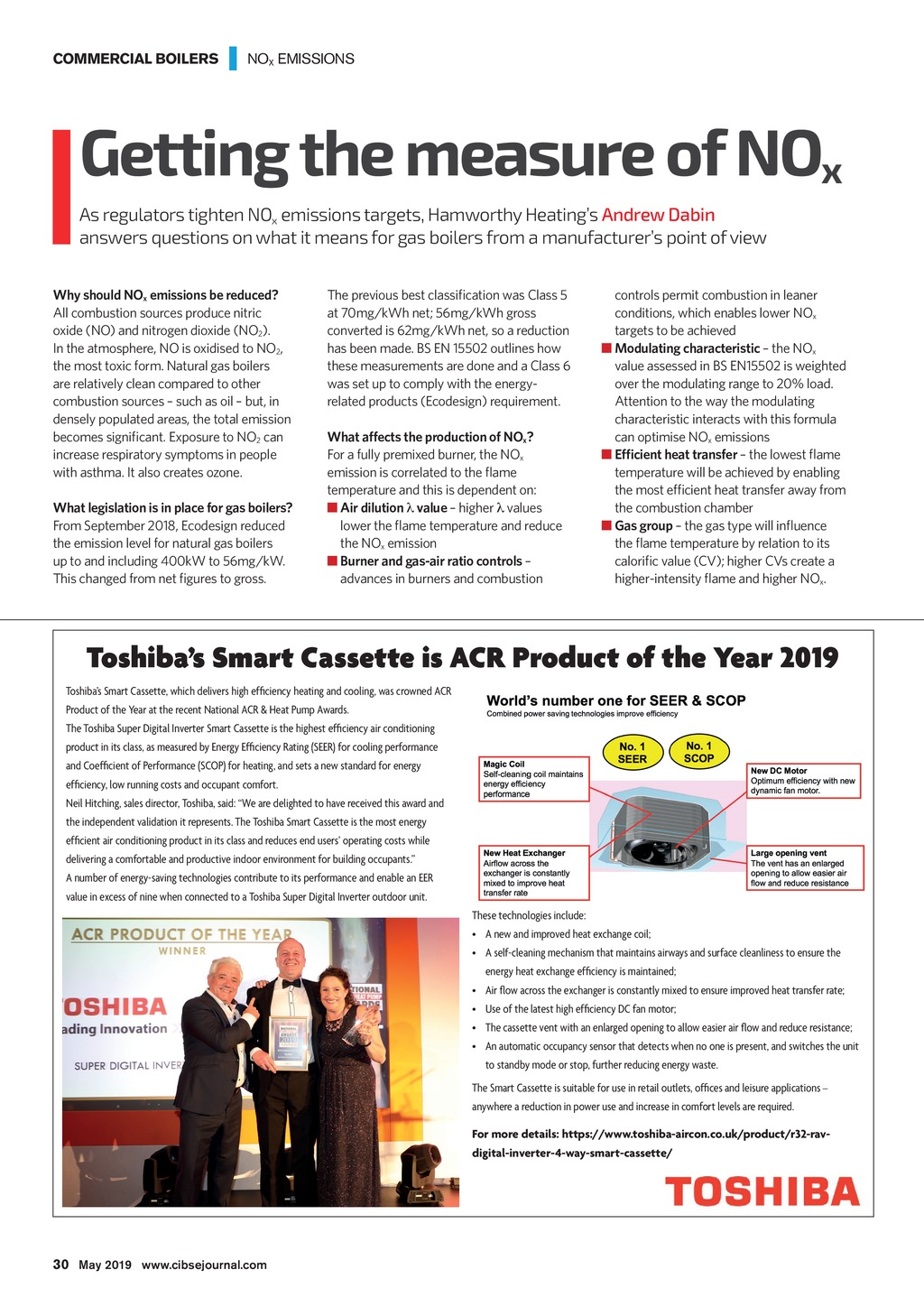




COMMERCIAL BOILERS | NOX EMISSIONS Getting the measure of NOx As regulators tighten NOx emissions targets, Hamworthy Heatings Andrew Dabin answers questions on what it means for gas boilers from a manufacturers point of view Why should NOx emissions be reduced? All combustion sources produce nitric oxide (NO) and nitrogen dioxide (NO2). In the atmosphere, NO is oxidised to NO2, the most toxic form. Natural gas boilers are relatively clean compared to other combustion sources such as oil but, in densely populated areas, the total emission becomes significant. Exposure to NO2 can increase respiratory symptoms in people with asthma. It also creates ozone. What legislation is in place for gas boilers? From September 2018, Ecodesign reduced the emission level for natural gas boilers up to and including 400kW to 56mg/kW. This changed from net figures to gross. Theprevious best classification was Class5 at 70mg/kWh net; 56mg/kWh gross converted is 62mg/kWh net, so a reduction has been made. BS EN 15502 outlines how these measurements are done and a Class6 was set up to comply with the energyrelated products (Ecodesign) requirement. What affects the production of NOx? For a fully premixed burner, the NOx emission is correlated to the flame temperature and this is dependent on: Air dilution value higher values lower the flame temperature and reduce the NOx emission Burner and gas-air ratio controls advances in burners and combustion controls permit combustion in leaner conditions, which enables lower NOx targets to be achieved Modulating characteristic the NOx value assessed in BS EN15502 is weighted over the modulating range to 20% load. Attention to the way the modulating characteristic interacts with this formula can optimise NOx emissions Efficient heat transfer the lowest flame temperature will be achieved by enabling the most efficient heat transfer away from the combustion chamber Gas group the gas type will influence the flame temperature by relation to its calorific value (CV); higher CVs create a higher-intensity flame and higher NOx. Toshibas Smart Cassette is ACR Product of the Year 2019 Toshibas Smart Cassette, which delivers high efciency heating and cooling, was crowned ACR Product of the Year at the recent National ACR & Heat Pump Awards. The Toshiba Super Digital Inverter Smart Cassette is the highest efciency air conditioning product in its class, as measured by Energy Efciency Rating (SEER) for cooling performance and Coefcient of Performance (SCOP) for heating, and sets a new standard for energy efciency, low running costs and occupant comfort. Neil Hitching, sales director, Toshiba, said: We are delighted to have received this award and the independent validation it represents. The Toshiba Smart Cassette is the most energy efcient air conditioning product in its class and reduces end users operating costs while delivering a comfortable and productive indoor environment for building occupants. A number of energy-saving technologies contribute to its performance and enable an EER value in excess of nine when connected to a Toshiba Super Digital Inverter outdoor unit. These technologies include: A new and improved heat exchange coil; A self-cleaning mechanism that maintains airways and surface cleanliness to ensure the energy heat exchange efciency is maintained; Air ow across the exchanger is constantly mixed to ensure improved heat transfer rate; Use of the latest high efciency DC fan motor; The cassette vent with an enlarged opening to allow easier air ow and reduce resistance; An automatic occupancy sensor that detects when no one is present, and switches the unit to standby mode or stop, further reducing energy waste. The Smart Cassette is suitable for use in retail outlets, ofces and leisure applications anywhere a reduction in power use and increase in comfort levels are required. For more details: https://www.toshiba-aircon.co.uk/product/r32-ravdigital-inverter-4-way-smart-cassette/ 30 May 2019 www.cibsejournal.com CIBSE May19 pp30-31 Hamworthy NOX Supp.indd 30 26/04/2019 16:21